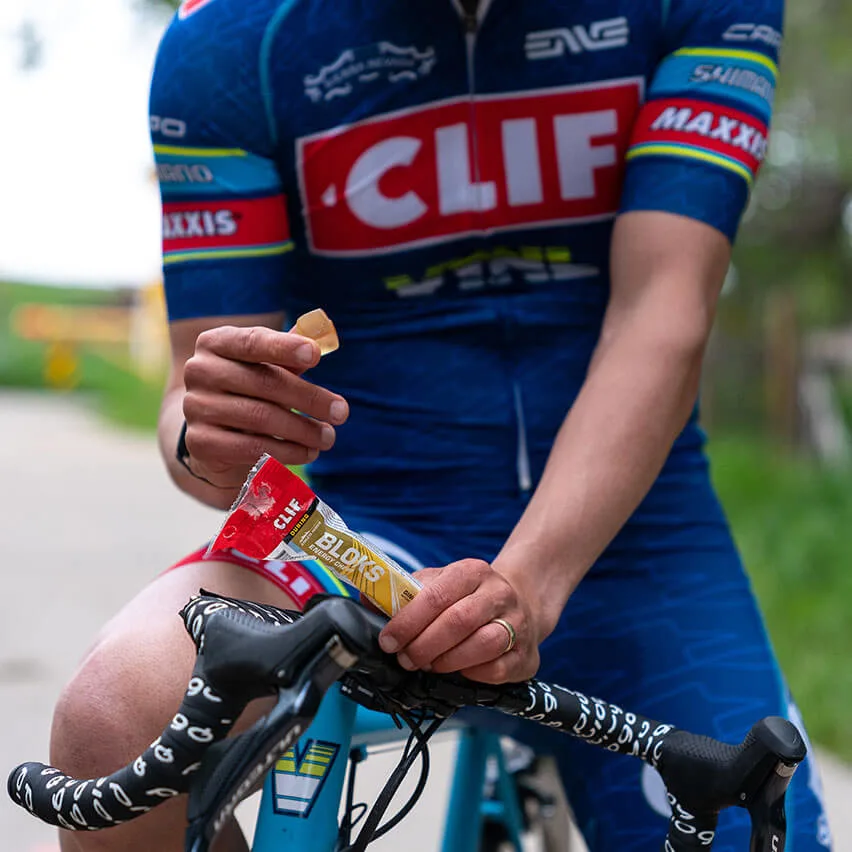
The ideas and suggestions written below are provided for general educational purposes only and should not be construed as medical advice or care. Always seek the advice of a doctor or other qualified professional before beginning any physical fitness or health- and nutrition-related activity.
Replace with: Nutrition plays an important role in optimizing performance before, during and after exercise. While CLIF BAR energy* baris purposefully crated with a blend of plant-based protein, fat and carbohydrates with phosphorus to energize* you BEFORE or DURING a workout (learn more about What to Eat Before A Workout), did you know that what you eat AFTER exercise is just as important for performance? And when it comes to fueling recovery after a tough workout, protein is key.”
*Phosphorus contributes to normal energy-yielding metabolism.
1. How does protein repair and rebuild muscle?
Protein is made up of amino acids, which act like building blocks for the body. When you eat protein after exercise, it gives your muscles the amino acids necessary to repair and rebuild.
And why is this important? Well, repetitive muscle contractions from jumping, running, and other forms of exercise can break down muscle cells and cause damage to the muscles in your arms, legs, and the rest of your body.
Taking in enough protein after exercise helps reverse damage, build muscle, and get you ready for the next tough workout.
2. How much protein do you need for muscle recovery?
“Protein synthesis” is the scientific way of saying “repairing and growing muscle.” Post-exercise intake of about 0.2–0.5 grams of protein per kilogram of body weight (g/kg) has been shown to increase this muscle protein synthesis.1 That’s about 10–30g of protein, depending on your body weight and the intensity and duration of your workout. The longer and more intense the exercise, the more protein is needed to optimise recovery. Over the course of the day, active individuals should aim to eat about 10–20 per cent of their total daily energy intake from protein (or about 50–100g, based on a 2,000-calorie diet). Athletes may need even more protein and should aim for 1.2–2g/kg each day.1
While protein gets most of the glory when it comes to post-exercise fuel, carbohydrates have a role to play, too.2,3,4 In fact, carbohydrates and protein in a 3:1 or 4:1 ratio have been found to help maximise recovery by replenishing energy stores.5
With a blend of carbs and protein, some of my favourite recovery foods include a glass of chocolate milk, the American classic peanut butter and jam sandwich.
3. Why is it important to have protein right after a workout?
Intense or prolonged activity causes an increase in muscle protein breakdown. This is followed by an increase in muscle protein synthesis over the next 24 hours.6 For that reason, it’s important to consider both the amount of protein you eat and when you eat it.
Ideally, protein should be eaten within 30 minutes of finishing a workout. Combined with simple carbohydrates (i.e., sugar), your post-exercise snack can help both replenish energy stores and rebuild muscle. Miss the 30-minute window? While less effective, fuelling any time after activity is still important and can be beneficial.7
4. What type of protein is best after a workout?
From whole foods to supplements and animal- to plant-based proteins, there are many ways to meet your protein needs, and it can be confusing to navigate. Also known as complete proteins, high-quality proteins (those that are highly digestible and provide an adequate amount of essential amino acids, which our bodies can’t make) are most effective for building, repairing, and maintaining muscle.8
High-quality food sources of protein include dairy, fish, meat, eggs, and soy. However, that’s not the only type of protein that’s useful. You’ve likely seen whey (from dairy) and plant-based protein powders, concentrates, and isolates on the market, too.
Like soy, pea protein is a plant-based protein that has been found to be effective for post-workout recovery and can be used by all athletes — even those who follow a vegan diet. Just keep in mind, pea protein is an incomplete protein, meaning it delivers fewer essential amino acids, so you may have to eat more for the same recovery impact as whey or soy.
With that said, for most people, eating enough calories during the day and including a variety of plant-based foods in the diet can ensure adequate protein and amino acid intake.9 You don’t need to eat animal protein to support post-workout recovery; all types of protein can work.
5. What foods can help repair and rebuild muscle?
Whole foods are the foundation of a healthy diet, but a big, homecooked meal isn’t always convenient when on the go. Below are a few examples of nutritious, post-workout foods that can help promote recovery without slowing you down:
On-the-Go Options:
- Dried fruit and mixed nuts (about 30–60g)
- 240ml glass of chocolate milk
Quick At-Home Recipes:
- Yoghurt Parfait: 165g plant-based yoghurt + 80g mixed berries + walnuts
- Nut Butter Roll-Up: 1 flour tortilla + 2 tablespoons nut butter + half sliced banana + drizzle of honey
- Egg + Avocado Toast: 1 poached egg + 1 slice wholegrain toast + half avocado
- Open-Faced Turkey Sandwich: 2 turkey slices (about 60g) + 1 slice wholegrain bread + 1 slice of cheese (about 30g)
- Recovery Smoothie: 2 tablespoons plant-based protein powder + half banana + 250ml water or milk + ice (add 1 tablespoon nut butter for an extra protein punch!)
And if you have a little extra time on your hands and want to whip up one of my post-workout recipes, check out these cookies below.
Stephanie’s Recovery Cookies:
Ingredients:
- 250g nut butter
- 85g maple syrup
- 45g mini chocolate chips
- 6 dates, pitted, soaked in hot water and mashed into a paste
- 2 eggs
- 1/4 tsp bicarbonate of soda
- 1/4 tsp vanilla extract
- pinch of salt
Directions: Mix together, spoon onto a baking tray, and bake at 175C/gas mark 4 for 10 mins. Allow to cool before enjoying!
References
- Position of the Academy of Nutrition and Dietetics, Dietitians of Canada, and the American College of Sports Medicine: Nutrition and Athletic Performance. J Acad Nutr Diet. 2016;116:501-528.
- Blom PC, Hostmark AT, Vaage O, Kardel KR, Maehlum S. Effect of different post-exercise sugar diets on the rate of muscle glycogen synthesis. Med Sci Sports Exerc. 1987;19:491-6.
- Kerksick CM, Arent S, Schoenfeld BJ, et al. International society of sports nutrition position stand: nutrient timing. J Int Soc Sports Nutr. 2017;14:33. Published 2017 Aug 29. doi:10.1186/s12970-017-0189-4.
- Trommelen J, et al. Fructose coingestion does not accelerate postexercise muscle glycogen repletion. Med Sci Sports Exerc. 2016;48(5):907-12.
- Kerksick, C., Harvey, T., Stout, J., Campbell, B., Wilborn, C., Kreider, R., Kalman, D., Ziegenfuss, T., Lopez, H., Landis, J., Ivy, J. L., & Antonio, J. (2008). International society of sports nutrition position stand: nutrient timing. J Int Soc Sports Nutr. 5:17.
- Burd, N.A., West, D.W., Moore, D.R. et al. Enhanced amino acid sensitivity of myofibrillar protein synthesis persists for up to 24 h after resistance exercise in young men. J Nutr. 2011; 141: 568–573.
- Areta, J.L., Burke, L.M., Ross, M.L. et al. Timing and distribution of protein ingestion during prolonged recovery from resistance exercise alters myofibrillar protein synthesis. J Physiol. 2013; 591: 2319–2331.
- Tipton, K.D., Elliott, T.A., Cree, M.G., Aarsland, A.A., Sanford, A.P., and Wolfe, R.R. Stimulation of net muscle protein synthesis by whey protein ingestion before and after exercise. Am J Physiol Endocrinol Metab. 2007; 292: E71–E76.
- Position of the Academy of Nutrition and Dietetics: Vegetarian Diet. The Journal of the Academy of Nutrition and Dietetics. J Acad Nutr Diet. 2016 Dec;116(12):1970-1980. doi: 10.1016/j.jand.2016.09.02.

